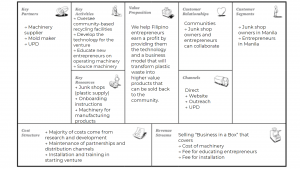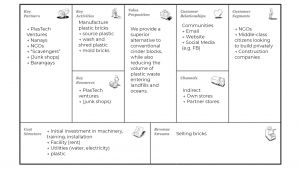A. Refine your Business Model Canvas:
- Include a Visual Canvas
For the Venture:
For the entrepreneur:
- Extremely specific notes for each block
Customer Segments – Our primary customer segments are Junk Shops and Entrepreneurs in Manila. When selling our “business in a box” model, it will appeal most to individuals trying to boost their personal income by starting a business because the business model is already laid out for them, they just have to implement it.. Targeting junk shops will give them the opportunity to create value from the cleaned and recycled plastic they are already collecting; however, not all junk shops will have the real estate and manpower to expand into manufacturing. Entrepreneurs may be more likely to start from scratch and purchase a facility and hire individuals to work the machines, while partnering with junk shops to source their plastic.
Customer Relationships – At steady state, forming a Community for the junk shops and entrepreneurs that comprise the community-based recycling system will allow individuals to learn from each other, increasing the sustainability of the venture. Reducing the need for intervention from PlasTech Ventures, except for the initial purchase and installation of machine, will help the communities to reach a new equilibrium that does not foster dependency.
Channels – We will rely mainly on indirect channels to reach our customers. A website will be used to spark interest and provide information on both the recycling technology and business opportunity. We will utilize our connection with the UPD to further expand our venture in the Philippines.
Value Proposition – We help Filipino entrepreneurs earn a profit by providing them the technology and a business model that will transform plastic waste into higher value products that can be sold back to the community.
Key Partners – The partners that will be essential to our ventures success are the companies that manufacture the machinery and molds for the brick design that are included as part of the “business in a box.” Our partnership with the UPD gives us credibility and allows us to tap into the existing connections that UPD has with the Filipino communities.
Key Activities – The key activities for the venture at steady-state will be overseeing the network of community-based recycling facilities and educating new entrepreneurs. The team will stay connected with all of the recycling facilities to provide direct support and ensure that the operation runs smoothly. The team will need to develop an on-boarding strategy and machinery training for new entrepreneurs. In order to reach the steady-state point, the PlasTech Venture team must first develop the product suite, develop the technology to produce the products, and establish a business network for the venture in the Philippines.
Key Resources – One key resource for the steady-state operation of our venture is the junk shops that supply the plastic for production. Another key resource is the on-boarding instruction which will play a crucial role in familiarizing the entrepreneur in operating the machinery and business. The machinery itself is also a key resource that will be important in order to produce the goods that will be sold in the market.
Revenue Streams – PlasTech Venture’s primary revenue stream will be selling the “business in a box” model to entrepreneurs in the Philippines. This model will include the machinery and mold to manufacture bricks, an installation fee, and a training fee
Cost Structure – The majority of the costs at steady state for the venture will come from outreach both to the entrepreneurs and market for recycled plastic products, research and development, and maintaining partnerships and supply chains. Installing the machinery at the recycling facility and providing the necessary training to operate the machinery will also contribute to the cost.
- Explain how exactly you will deliver an end-to-end solution.
- Reach out to entrepreneurs and junk shops in the Philippines to generate interest in starting a collaboration with PlasTech Ventures in their region.
- Collaborate with the entrepreneur to network and establish a steady supply of clean and sorted recycled plastics for the facility
- Provide the machinery to the entrepreneur and help them install the machinery in the facility
- Provide a machinery maintenance plan and training for operating the machinery
- Maintain connection with the entrepreneur/junk shop to provide technical support when requested
B. Ten practical lessons from the business (revenue) models of ventures we reviewed today (or others you research) as they relate to your venture.
- Envirofit: Display the value proposition that is specific to both the customer and other stakeholders. On Envirofit’s website, the “Reducing GHG emission by 60%” is appealing to groups such as the government while the “$2.50 savings per week” is appealing to the customers who will be using the technology
- Greyston Bakery: Doing socioeconomic good that allows the company to give back to the community. In return customers become more willing to make purchases from the company knowing and trusting that the company is doing good for the community.
- Reel: Providing an opportunity for customers to not only grow their own produce in a simple way but to also save valuable resources (80% less water).
- Barefoot College: “You are certified by the community you serve. You don’t need a paper…to show that you are an engineer”. There is a greater significance and value in taking action and showing your capabilities rather than stating what you may potentially achieve.
- Value propositions are short and to the point, making them very compelling. The value proposition can simply pitch the impact.
- The business model for Greyston Bakery is focused on “creating prosperity all along the value chain.” This allows the business to profit, but also benefits the community. This starts with the open hiring process. Their slogan, “we don’t hire people to bake brownies, we bake brownies to hire people,” confirms that their motivation for starting the business was not just profit.
- By simplifying the gardening process, Reel Gardening expanded their reachable market by eliminating the need for skilled labor.
- Business innovations do not always have to be technological, it could be an improvement in a company’s hiring processes that offer human support and introduce a new frame of thinking. In Greyston Bakery’s case, they gave previously imprisoned people the opportunity to rebuild their life, from providing affordable housing to even providing childcare for employees.
- This college only for the poor (Barefoot College) redefined professionalism – Roy wanted to illustrate that its students’ knowledge and skills were universal and relevant, even if they were not learned in the form of a traditional education. This new educational institution offered opportunities for people that would not have otherwise had the opportunity to attend school. This encourages entrepreneurs to think differently and look out for opportunities to help underrepresented people as we can learn a lot from the skills they offer, even if they may be different from the skills we have.
- In the Barefoot College example, I thought it was really interesting that he used sign language to train the three women to become solar engineers. This shows that language barriers will not deter dedicated workers from making progress and making real change happen. The initial training created a ripple effect that perpetuated the spread of knowledge to multiple communities, since these women were able to communicate what they learned to their community that spoke their own language. Roy also mentioned that people don’t have to look for solutions outside – they can look for solutions within, and people should always be willing to listen to others, because people may just have solutions right in front of them.


